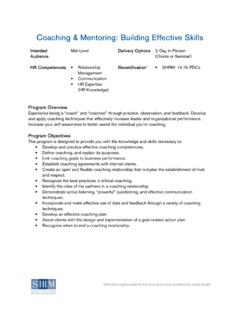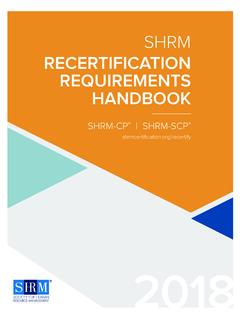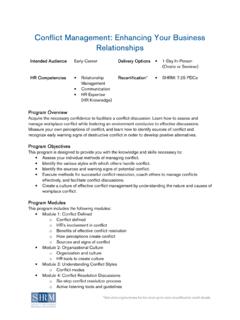Transcription of Code of Ethics - SHRM Online
1 A guide To Developing Your Organization's code of Ethics 2001 Ethics Resource Center SHRM Toolkit 2001 Ethics Resource Center All rights reserved. No part of this publication may be reproduced, stored in a retrieval system, or transmitted, in any form or by any means, electronic, mechanical, photocopying, recording, or otherwise, without prior written permission from the Ethics Resource Center. This toolkit is for SHRM members only and is not to be copied or distributed to anyone other than a SHRM member. Printed in the United States.
2 I Ethics Resource Center 2001. Table of Contents A Message from the CEO iii I. Introduction 1. II. What is a code of Ethics and What is its Role? 2. III. How Should a code of Ethics be Written? 3. code Format Guidelines for Writing an Ethics code IV. What is in a code of Ethics ? 4. code Content Title Leadership Letter Table of Contents Introduction/Prologue Statement of Values code Provisions Information and Resources V. How are Codes of Ethics Developed? 8. Planning Data Intake code Drafting Communications and Education Strategies code Revisions SHRM code of Ethics Checklist VI.
3 Sample Forms and Tools for code Development 13. Writing A code Provision-A Template Sample code Provision Using an Informal Survey to Gather Information Sample Survey Questions Using Interviews and Focus Groups to Gather Information Sample Interview and Focus Group Questions VII. Where to Get Additional Help 18. ii Dear SHRM Members .. As you are probably aware, the Society for Human Resource Management has committed to making Ethics a priority in our organization and for our profession. As part of an overall Ethics initiative, we have recently developed a new SHRM code of Ethical and Professional Standards in Human Resource Management.
4 The code was written entirely by a task force committee of SHRM members and leaders with the assistance of the Ethics Resource Center (ERC), a non-profit, nonpartisan educational organization with an Advisory Services division, which offers business Ethics consulting expertise. Hundreds of members and leaders were interviewed in focus groups conducted around the country and with a cross-section of our membership. SHRM members may choose to use this guide to create a code of Ethics for their own organizations. The code of Ethics Toolkit: A guide to Developing a code of Ethics ( code of Ethics Toolkit) has two purposes: 1) It outlines the process by which the SHRM member code was developed.
5 2) It can serve as a guide in designing a code of Ethics for organizations in which you work. This toolkit, plus the additional information provided on the SHRM website and the offer of additional expert assistance when requested are all part of a coordinated effort to serve the needs of our members and strengthen the bonds and mission that we all share. Thank you. Helen Drinan, SPHR. President & CEO. Society for Human Resource Management iii I Introduction . A code of Ethics can make a difference in your organization.
6 Beyond clarifying gray areas and providing guidance on everything from the simplest of questions to the most complex ethical dilemma, a code can help your organization to: Build trust internally and externally;. Increase awareness of key ethical issues;. Stimulate and legitimize ethical dialogue;. Build consensus around vital issues;. guide decision-making;. Encourage staff to seek advice;. Foster the reporting of misconduct and related concerns; and Clarify where employees should go to seek advice. A code of Ethics offers an invaluable opportunity for a responsible organization to further its positive public identity.
7 This can lead to a more supportive environment and an increased level of public confidence and trust among important Together these benefits can make a profound and positive impact on the culture of your organization. They combine to provide a persuasive rationale for creating a code of Ethics should you choose to do that. 1 Principles of Stakeholder Management, The Clarkson Centre for Business Ethics , 1999, p. 12. 1. II What is a code of Ethics and What is its Role? A. code of Ethics ( code ) serves as a central guide to support day-to-day decision making at work.
8 It clarifies the cornerstones of your organization-- its mission, values and principles . helping your staff understand how these cornerstones translate into everyday decisions, behaviors and actions. While some may believe codes are designed to limit one's actions, the best codes are actually structured to liberate and empower people to make more effective decisions with greater confidence. An effective code has many uses, but two critical ones stand out. A code should (1) clarify gray areas or questions employees have concerning organizational values and expectations and (2) help build trust and commitment.
9 At best, a code reflects the covenant that [your] Codes are Designed to .. organization has made to uphold its most important 1. Raise ethical expectations (aspirational values, dealing with such matters as its commitment provisions). to employees, its standards for doing business and its relationship with the community. 2 2. Legitimize dialogue about ethical issues (communication provisions). A code also serves as a key reference tool. Use it to locate key documents, support services and other 3. Encourage ethical decision-making resources related to Ethics and values within your (judgment provisions).
10 Organization. 4. Prevent misconduct provide a basis for For all that a code is, it is not meant to stand alone. enforcement (accountability and It cannot address all of an organization's Ethics enforcement provisions). needs, nor can it answer every ethical question or issue that may arise. Rather, view your code as one key element in a broader effort to make Ethics a priority at your organization-- a critical bridge for helping to put your ethical principals into practice. 2 Driscoll, Dawn-Marie and W. Michael Hoffman, Ethics Matters: How to Implement Values-Driven Management, 2000, p.









